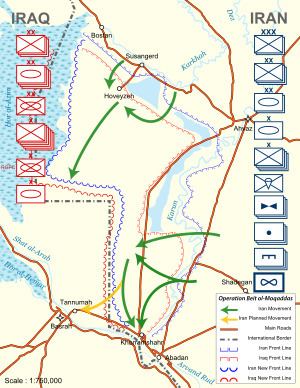Dates 24 Apr 1982 – 22 May 1982 | Result Decisive Iranian victory | |
 | ||
70,000-80,000 fighters90 infantry battalions43 armored battalions23 mechanized battalions22 commando battalions12 border guard battalions30 artillery battalions1,435 tanks, 1,330 APCs, 530 artillery pieces 65,000 fighters112 infantry battalions23 armored battalions9 mechanized battalions29 artillery battalions5 combat engineer battalions1 pontoon bridge battalion4 Army Aviation units (96 helicopters)700 tanks 16,000 killed and wounded19,070 captured418 tanks and APCs, 200 vehicles, 40 aircraft, 3 helicopters, and 30 artillery pieces destroyed150 tanks and APCs, 300 vehicles, 1 hellicopter, 18 artillery pieces, 95,000 mines, and dozens of ammunition depots captured 30,000 killed and wounded4 helicopters destroyed Similar Liberation of Khorramshahr, Iran–Iraq War, Operation Dawn 8, Operation Kheibar, Siege of Basra | ||
Iran iraq war freedom of khoramshahr operation beit ol moqaddas mixed with real footage
Operation Beit-ol-Moqaddas (Jerusalem) (Persian: عملیات بیتالمقدس) was an Iranian operation conducted during the Iran–Iraq War. The operation was a success, in as so far as it achieved its standing aim of liberation of Khorramshahr and pushing Iraqi troops back to the border. This operation, coupled with Operation Tariq al-Qods, and Operation Undeniable Victory, succeeded in evicting Iraqi troops from southern Iran and gave Iran the momentum.
Contents
- Iran iraq war freedom of khoramshahr operation beit ol moqaddas mixed with real footage
- Iran iraq war child soldier mixed with real footage operation beit ol moqaddas
- Prelude
- Battle
- Iran
- Iraq
- References
Iran iraq war child soldier mixed with real footage operation beit ol moqaddas
Prelude
On September 22, 1980, because of his desire that Iraq should have complete dominance over the Shatt al-Arab (or the Arvand Rūd) waterway, Iraqi President Saddam Hussein declared war against Iran and launched a land invasion of southern Iran, although operations did occur elsewhere on the Iran–Iraq border. After achieving successes due to the post-Revolution military and political chaos in Iran, Saddam Hussein ordered that the Iraqi troops "dig-in" on the front line. He hoped that this would show the world that he cared about the fate of the Iranian people, and that he was only concerned with achieving his aim of securing the entire Shatt al-Arab waterway, which had been under dispute since the 1975 Algiers Agreement. However, since the Islamic Revolution of Iran in 1979, Iraq had felt that it was necessary to assume what it wanted through force, since previous attempts in getting the revolutionary Iranian government to negotiate a new settlement had proved fruitless.
Once the Iraqi forces had settled, the Iranians were planning a series of operations designed to evict the Iraqis from southern Iran, of which Operation Tariq al-Qods was one.
Battle
The Iranians attacked, with some 70,000 soldiers in the Ahvaz–Susangerd area. The Iraqi forces in the area withdrew, and strengthened the defenses of Khorramshahr.
The Iraqis launched a counter-offensive on 20 May. However, despite its scale, the Iranians were able to repulse the attack.
On 22 May, the Iranians liberated Khorramshahr; the vitally strategically and symbollically important Iranian city whose capture by Iraq had been the low-point of Iranian fortunes in the early days of the war
The Iraqis were ordered to retreat, although many had done when Khorramshar had fallen, back into Iraq. The Iranians captured 15,000-19,000 Iraqi troops and a substantial amount of Iraqi military hardware in Khorramshahr.
The numbers of casualties sustained by Iraq and Iran are unknown; but it is likely that there was not marked a difference between both sides. Iranian forces was a combination of regular Army together with Pasdaran and Basij fighters, which it would come to rely on later in the war from 1983 onwards.
The commander of the Iraqi forces in the city, Colonel Ahmad Zeidan, attempted to flee, but was trapped in a minefield which previously had been set up on his orders, and killed when he stepped on a mine.
Iran
Iranian units involved in the operation were as follows: Each IRGC battalion was consisted of 300 Basij volunteers at most, while each Army battalion was around 2.5 times bigger. However, the number of battalions in each IRGC brigade was bigger than those of the Army.
Karbala Central Headquarters
Commanded by Mohsen Rezaei (IRGC commander) and Col. Ali Sayyad Shirazi (Army commander)
Commanded by Gholam Ali Rashid and Col. Massoud Monfared Niyaki
Commanded by Hossein Kharrazi
Commanded by Ahmad Kazemi
Commanded by Morteza Ghorbani
Commanded by Hassan Baqeri and Col. Hossein Hassani Saadi
Commanded by Abdol-Mohammad Raoofi-Nezhad
Commanded by Ahmad Motevasselian
Commanded by Ahmad Gholampoor and Col. Siroos Lotfi
Commanded by Mehdi Bakeri
Commanded by Ali Hashemi
Commanded by Qassem Soleimani
Combat engineer units involved were as follows:
Other forces included:
Iraq
Iraqi units involved in the operation were as follows:
Commanded by Brig. Gen. Jawad Asaad
